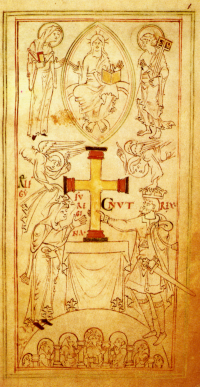Winchester Cross
Cnut Cross
King Cnut the Great (c. 985 or 995 to 1035) is perhaps best well known for his failed attempt to command the waves to retreat. Sadly, despite recent proof (?) the story is most likely apocryphal.
What is undisputed, however, was the existence of a Cnut Cross.
Cnut was keen to be recognised as Christian and presented the Church with all manner of gifts to prove his point. Gifts to the Church are not a mark of Christianity but as with other religions, it's common for Christians to give tithes and share their wealth either as a gift to the Church, or to be distributed to the poor.
Cnut ordered the repair and rebuilding of several monasteries and church buildings, especially those plundered by Viking raiders.
One particular gift was to the New Minster in Winchester, Hants. This was a royal Benedictine abbey founded in 901 by King Edward the Elder and later supported by Cnut. In addition to the relics of St. Birinus, gold and silver, Cnut also presented a golden cross.
An illuminated manuscript of the abbey's 11th century Liber Vitae (shown on the right) depicts Cnut and Ælfgifu (Emma) presenting the golden cross to the church. It is a Latin Cross with stubby ends stylizing Roman column heads and bases. In heraldry this is known as Corniced, Cornished, Capital or Capiteau Cross. There is also a Viking influence in the design. (See Thor Cross)
The Institute of Historical Research and the History of Parliament Trust explains:
King Cnut was a great benefactor to the Minster, not only in lands but by the gift of the golden cross richly adorned with precious stones with two great images of gold and silver and sundry relics of saints. Among other benefactions received by the monastery at about this time was the gift in 1041 by Queen Emma, relict [widow] of Cnut, of the head of St. Valentine, which was cherished as one of the most valuable possessions of the house.
'Houses of Benedictine monks:
New Minster, or the Abbey of Hyde',
A History of the County of Hampshire:
Volume 2 (1973), pp. 116-122.
In 1109 Henry I directed that the monks move a little further north to more spacious premises called Hyde Mead, just outside Winchester's city wall. They took with them the relics and the cross given by Cnut. A few years later, however, a civil war broke out (between supporters of King Stephen and Matilda) and in 1141 the city was in flames. Hyde Abbey was destroyed and the cross burnt.

Crosses appear on several Cnut pennies but these suggest Christianity generally rather than a particular Cnut Cross
(Click photo to enlarge)
A replica was made when the abbey was restored in the late 12th century, only to be dissolved and demolished in 1538/9 by King Henry VIII. (This was soon after Henry fell out with the Church over the pope's objection to Henry's marriage to Anne Boleyn. He later fell out with Anne Boleyn and had her head chopped off. It took a lot to satisfy Henry. See Albert and the 'Eadsman)
If the golden cross still existed by 1538, it was probably melted down by Thomas Cromwell or one of his commissioners, either for Henry's war chest (to vanquish France and Scotland) or as annuities for the old Benedictine monks.
Buttercross
This current tourist attraction on the High Street of the city of Winchester is known variously as High Cross, City Cross and Butter Cross. It stands on a plinth of five octagonal steps and is located near a narrow passage that leads to Great Minster Street.
The original was erected in the 14th century and in 1770 it was sold to a Mr Dummer. But when he attempted to dismantle it, the locals protested violently so the structure stayed where it was.
The oldest part now is a 15th century statue (south facing) representing either St. John the Evangelist or St. Amphibalus, one of the first British Martyrs (killed on 25 June 304 AD). He was the patron of Winchester Cathedral before it was dedicated to St. Swithun.
Three other large statues on the monument represent William of Wykeham, Lawrence de Anne (a Winchester mayor) and Aelfred the Great. There are also eight smaller statues near the top representing the Blessed Virgin Mary, St. Bartholomew, St. John, St. Lawrence, St. Maurice, St. Peter, St. Swithun and St. Thomas. All these statues were added by Mr G G Scott in 1865.
Jesus said "It is easier for a camel to go through the eye of a needle than for a rich man to enter the kingdom of God." Parallel versions appear in Matt. 19:23-24), Mark 10:24-25) and Luke 18:24-25).
Gold is very heavy. If the cross was as large as shown in the illustration (say 1 metre high, 70 cm wide, 12 cm thick: 24,480 cm3) and made of solid gold, it would weigh nearly half a ton.
Other crosses appear on coinage of an earlier King Cnut from Viking Northumbria, dating from the beginning of the 10th century


